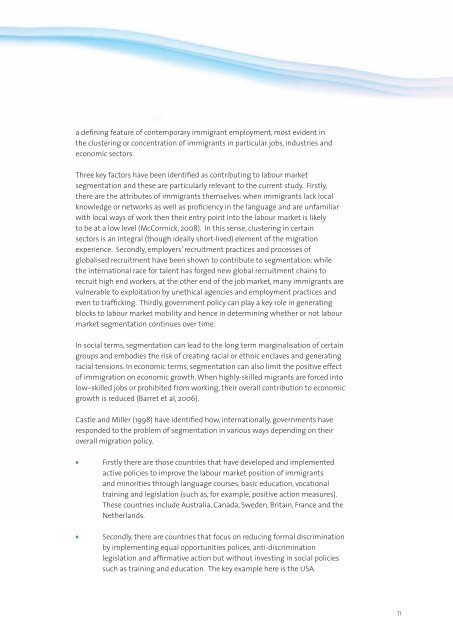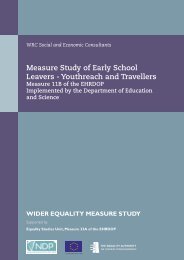Issues and Challenges in the Recruitment and Selection of ...
Issues and Challenges in the Recruitment and Selection of ...
Issues and Challenges in the Recruitment and Selection of ...
You also want an ePaper? Increase the reach of your titles
YUMPU automatically turns print PDFs into web optimized ePapers that Google loves.
a def<strong>in</strong><strong>in</strong>g feature <strong>of</strong> contemporary immigrant employment, most evident <strong>in</strong><strong>the</strong> cluster<strong>in</strong>g or concentration <strong>of</strong> immigrants <strong>in</strong> particular jobs, <strong>in</strong>dustries <strong>and</strong>economic sectors.Three key factors have been identified as contribut<strong>in</strong>g to labour marketsegmentation <strong>and</strong> <strong>the</strong>se are particularly relevant to <strong>the</strong> current study. Firstly,<strong>the</strong>re are <strong>the</strong> attributes <strong>of</strong> immigrants <strong>the</strong>mselves: when immigrants lack localknowledge or networks as well as pr<strong>of</strong>iciency <strong>in</strong> <strong>the</strong> language <strong>and</strong> are unfamiliarwith local ways <strong>of</strong> work <strong>the</strong>n <strong>the</strong>ir entry po<strong>in</strong>t <strong>in</strong>to <strong>the</strong> labour market is likelyto be at a low level (McCormick, 2008). In this sense, cluster<strong>in</strong>g <strong>in</strong> certa<strong>in</strong>sectors is an <strong>in</strong>tegral (though ideally short-lived) element <strong>of</strong> <strong>the</strong> migrationexperience. Secondly, employers’ recruitment practices <strong>and</strong> processes <strong>of</strong>globalised recruitment have been shown to contribute to segmentation: while<strong>the</strong> <strong>in</strong>ternational race for talent has forged new global recruitment cha<strong>in</strong>s torecruit high end workers, at <strong>the</strong> o<strong>the</strong>r end <strong>of</strong> <strong>the</strong> job market, many immigrants arevulnerable to exploitation by unethical agencies <strong>and</strong> employment practices <strong>and</strong>even to traffick<strong>in</strong>g. Thirdly, government policy can play a key role <strong>in</strong> generat<strong>in</strong>gblocks to labour market mobility <strong>and</strong> hence <strong>in</strong> determ<strong>in</strong><strong>in</strong>g whe<strong>the</strong>r or not labourmarket segmentation cont<strong>in</strong>ues over time.In social terms, segmentation can lead to <strong>the</strong> long term marg<strong>in</strong>alisation <strong>of</strong> certa<strong>in</strong>groups <strong>and</strong> embodies <strong>the</strong> risk <strong>of</strong> creat<strong>in</strong>g racial or ethnic enclaves <strong>and</strong> generat<strong>in</strong>gracial tensions. In economic terms, segmentation can also limit <strong>the</strong> positive effect<strong>of</strong> immigration on economic growth. When highly-skilled migrants are forced <strong>in</strong>tolow–skilled jobs or prohibited from work<strong>in</strong>g, <strong>the</strong>ir overall contribution to economicgrowth is reduced (Barret et al, 2006).Castle <strong>and</strong> Miller (1998) have identified how, <strong>in</strong>ternationally, governments haveresponded to <strong>the</strong> problem <strong>of</strong> segmentation <strong>in</strong> various ways depend<strong>in</strong>g on <strong>the</strong>iroverall migration policy.• Firstly <strong>the</strong>re are those countries that have developed <strong>and</strong> implementedactive policies to improve <strong>the</strong> labour market position <strong>of</strong> immigrants<strong>and</strong> m<strong>in</strong>orities through language courses, basic education, vocationaltra<strong>in</strong><strong>in</strong>g <strong>and</strong> legislation (such as, for example, positive action measures).These countries <strong>in</strong>clude Australia, Canada, Sweden, Brita<strong>in</strong>, France <strong>and</strong> <strong>the</strong>Ne<strong>the</strong>rl<strong>and</strong>s.• Secondly, <strong>the</strong>re are countries that focus on reduc<strong>in</strong>g formal discrim<strong>in</strong>ationby implement<strong>in</strong>g equal opportunities polices, anti-discrim<strong>in</strong>ationlegislation <strong>and</strong> affirmative action but without <strong>in</strong>vest<strong>in</strong>g <strong>in</strong> social policiessuch as tra<strong>in</strong><strong>in</strong>g <strong>and</strong> education. The key example here is <strong>the</strong> USA.11




